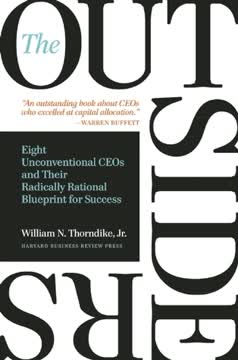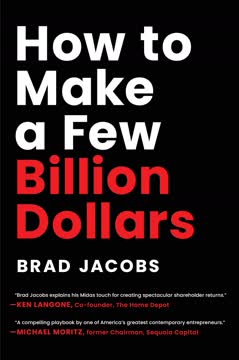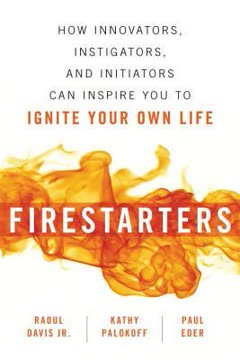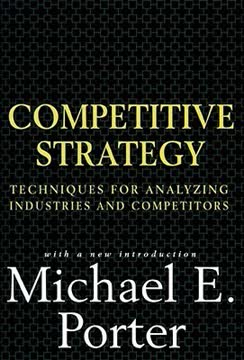Key Takeaways
1. Strategy is about being unique, not the best
Vying to be the best is an intuitive but self-destructive approach to competition.
Competing to be unique is the essence of strategy. This approach focuses on creating superior value for chosen customers, rather than trying to beat rivals at the same game. Unlike the zero-sum competition to be the best, competing to be unique allows for multiple winners in an industry.
Value creation is key. Companies succeed by offering distinctive products or services that meet specific customer needs better than alternatives. This uniqueness allows firms to command higher prices or achieve lower costs, or both. Examples include:
- Southwest Airlines: Low-cost, convenient travel on point-to-point routes
- IKEA: Affordable, stylish furniture for budget-conscious customers
- Apple: Premium, user-friendly technology products and ecosystem
By focusing on a specific value proposition and tailoring their activities accordingly, these companies have achieved sustained success without trying to be all things to all people.
2. The five forces shape industry competition and profitability
The real point of competition is not to beat your rivals. It's to earn profits.
Industry structure matters. Porter's Five Forces framework provides a comprehensive tool for analyzing the competitive dynamics of any industry:
- Threat of new entrants
- Bargaining power of suppliers
- Bargaining power of buyers
- Threat of substitute products or services
- Rivalry among existing competitors
These forces collectively determine industry profitability by influencing prices, costs, and investment requirements. Understanding this structure allows companies to:
- Identify strategic opportunities and threats
- Anticipate competitor moves
- Make informed decisions about entering or exiting markets
Industry analysis is dynamic. While industry structure tends to be stable over time, significant shifts can occur due to technological changes, regulatory reforms, or other external factors. Companies must continually monitor these forces to adapt their strategies accordingly.
3. Competitive advantage stems from relative price or cost differences
If you have a real competitive advantage, it means that compared with rivals, you operate at a lower cost, command a premium price, or both.
Economic fundamentals drive advantage. Competitive advantage is not about vague notions of superiority, but concrete economic performance. It manifests in two ways:
- Relative price: The ability to charge more than competitors for equivalent benefits
- Relative cost: The ability to produce at lower cost than competitors
These advantages result from differences in the activities companies perform and how they perform them. The value chain concept helps analyze these activity differences systematically.
Measure and quantify advantage. Companies should rigorously assess their relative price and cost positions compared to rivals. This analysis provides a clear link between strategy and financial performance, guiding decision-making and resource allocation.
4. A tailored value chain is essential for strategy implementation
A distinctive value proposition will translate into a meaningful strategy only if the best set of activities to deliver it is different from the activities performed by rivals.
Activities are the building blocks of strategy. The value chain represents all the activities a company performs to design, produce, market, deliver, and support its product or service. A truly distinctive strategy requires a tailored configuration of these activities.
Alignment is crucial. Each activity in the value chain should reinforce the overall strategic positioning. Examples of tailored value chains include:
- Enterprise Rent-A-Car: Focusing on insurance replacement and other local rentals, with a distributed network of neighborhood locations
- Zara: Fast-fashion retailer with rapid design-to-store cycle, enabled by vertically integrated production and logistics
- IKEA: Self-service stores, flat-pack furniture, and customer assembly, all supporting its low-price positioning
By performing different activities or performing similar activities differently than rivals, companies create barriers to imitation and sustain their competitive advantage.
5. Trade-offs are the linchpin of sustainable competitive advantage
Strategy is making trade-offs in competing. The essence of strategy is choosing what not to do.
Choices create uniqueness. Trade-offs occur when activities are incompatible, forcing companies to choose one path over another. These choices are essential for strategy because they:
- Create and preserve differences between companies
- Limit what a company offers
- Protect against repositioners and straddlers
Examples of strategic trade-offs:
- Southwest Airlines: No meals, no seat assignments, point-to-point routes
- Edward Jones: Face-to-face financial advice, no online trading
- In-N-Out Burger: Limited menu, fresh ingredients, no franchising
Embrace limitations. Managers often resist trade-offs, trying to be all things to all customers. However, sustainable advantage comes from having a clear focus and willingly disappointing some potential customers to better serve others.
6. Fit amplifies competitive advantage and raises barriers to imitation
Fit locks out imitators by creating a chain that is as strong as its strongest link.
System-level thinking is key. Fit refers to how a company's activities reinforce one another. There are three types of fit:
- Simple consistency between activities
- Activities that reinforce each other
- Optimization of effort across activities
Fit creates synergies. When activities are highly integrated, the whole becomes greater than the sum of its parts. This amplifies competitive advantage by:
- Reducing costs
- Enhancing differentiation
- Making imitation more difficult
Mapping activity systems can reveal the interconnections that create fit. For example, Zara's fast-fashion system relies on the tight integration of design, production, and retail activities. This complex web of relationships is extremely difficult for competitors to replicate.
7. Continuity enables strategy development and adaptation over time
Paradoxically, continuity of strategy actually improves an organization's ability to adapt to changes in the environment and to innovate.
Strategy takes time to develop. Continuity allows companies to:
- Deepen their strategic position
- Build unique capabilities and skills
- Strengthen relationships with customers and suppliers
- Refine and improve their activities
Change within continuity. While the core value proposition remains stable, companies can and should continually innovate in how they deliver that value. Examples include:
- Walmart: Consistent low-price strategy, but continuous innovation in supply chain and technology
- IKEA: Enduring focus on affordable design, with ongoing product and store format evolution
Avoid frequent shifts. Changing strategy too often is costly and disruptive. It requires reconfiguring activities, realigning systems, and reeducating stakeholders. Continuity provides a stable foundation for effective adaptation to market changes.
8. Growth should deepen, not compromise, strategic positioning
The pressure to grow is among the greatest threats to strategy.
Grow within your strategy. Companies often undermine their positioning in pursuit of growth. Instead, focus on:
- Deepening penetration with core customers
- Extending the strategy to new geographic markets
- Expanding the value proposition in ways that reinforce the core strategy
Avoid damaging growth. Be wary of:
- Broadening the target market too far
- Adding products or services that blur your uniqueness
- Pursuing growth for its own sake, without regard for profitability
If profitable growth opportunities within the current strategy are exhausted, it may be better to return capital to shareholders rather than risk destroying value through ill-conceived expansion.
9. Innovation and disruption must be evaluated through a strategic lens
The idea that innovation allows you to ignore competition is a fairy tale.
Not all innovation is disruptive. True disruption occurs when new technologies or business models invalidate existing competitive advantages. However, most innovations can be incorporated into existing strategies or value chains.
Assess strategic impact. When evaluating new technologies or business models, consider:
- How they affect the five forces in your industry
- Whether they reinforce or undermine your current positioning
- Their potential to create new trade-offs or sources of fit
Adapt strategically. Even in the face of significant change, companies should evolve their strategies in ways that build on their existing strengths and unique positioning, rather than abandoning them entirely.
10. Strategy is crucial in all contexts, including unattractive industries and nonprofits
Strategy is necessary for any type of organization that serves customers or meets needs.
Unattractive industries require strategy. In challenging competitive environments, strategy becomes even more important. Companies can:
- Seek to reshape industry structure in their favor
- Find a defensible position within the existing structure
- Excel at both operational effectiveness and strategic positioning
Nonprofits need strategy too. While the profit motive is absent, nonprofits must still:
- Define clear goals and metrics for creating social value
- Make choices about which needs to serve and how
- Configure their activities to deliver maximum impact efficiently
Emerging markets present opportunities. Companies in developing economies should:
- Close operational effectiveness gaps with global leaders
- Develop distinctive strategies beyond low-cost advantages
- Consider regional expansion before targeting advanced markets
In all contexts, the fundamental principles of strategy – creating unique value through a tailored set of activities – remain relevant and powerful.
Last updated:
FAQ
What's "Understanding Michael Porter: The Essential Guide to Competition and Strategy" about?
- Overview: The book by Joan Magretta distills Michael Porter's influential ideas on competition and strategy, making them accessible to managers.
- Core Focus: It explains why some companies are more profitable than others and how they can sustain competitive advantages.
- Structure: The book is divided into two parts: understanding competition and understanding strategy, with practical insights and examples.
- Purpose: It serves as a comprehensive guide to Porter's frameworks, such as the five forces and the value chain, essential for strategic thinking.
Why should I read "Understanding Michael Porter"?
- Strategic Foundation: It provides a foundational understanding of Porter's frameworks, which are crucial for any serious strategic thinker.
- Practical Application: The book translates complex theories into actionable insights for managers in various industries.
- Clarifies Misconceptions: It addresses common misconceptions about competition and strategy, helping readers avoid common pitfalls.
- Timeless Relevance: Porter's ideas are not trendy but enduring, offering guidance that remains relevant in today's dynamic business environment.
What are the key takeaways of "Understanding Michael Porter"?
- Competition vs. Strategy: Competing to be unique is more sustainable than competing to be the best.
- Five Forces Framework: Industry structure determines profitability, and understanding it is crucial for strategic positioning.
- Value Chain Importance: Competitive advantage arises from performing activities differently or more efficiently than rivals.
- Trade-offs and Fit: Making trade-offs and ensuring fit across activities are essential for sustaining competitive advantage.
What is the Five Forces Framework according to Michael Porter?
- Industry Structure: The framework analyzes the competitive forces that shape industry profitability: rivalry, buyer power, supplier power, threat of substitutes, and threat of new entrants.
- Profitability Determinants: It explains how these forces impact prices, costs, and investment requirements, influencing industry attractiveness.
- Strategic Insight: Understanding these forces helps companies position themselves where the forces are weakest or can be reshaped in their favor.
- Dynamic Nature: Industry structure is dynamic, and the framework helps anticipate and exploit changes in the competitive landscape.
How does the Value Chain create competitive advantage?
- Activity Focus: The value chain disaggregates a company into its strategically relevant activities, highlighting sources of competitive advantage.
- Cost and Value Drivers: It identifies activities that impact costs and customer value, linking them directly to financial performance.
- Tailored Activities: Competitive advantage arises from performing activities differently or more efficiently than rivals.
- Strategic Alignment: The value chain ensures that all activities are aligned with the company's value proposition and strategic goals.
What role do trade-offs play in strategy?
- Essential Choices: Trade-offs are crucial because they require companies to choose what not to do, creating a unique strategic position.
- Sustainability: They make strategies sustainable by deterring imitation, as rivals cannot easily copy without compromising their own strategies.
- Economic Linchpin: Trade-offs are the economic linchpin of strategy, enabling differences in cost and value that underpin competitive advantage.
- Strategic Clarity: They help clarify the company's focus, ensuring resources are directed toward activities that reinforce the strategy.
What is the significance of fit in a strategy?
- Activity Interconnection: Fit refers to how activities in the value chain relate to and reinforce each other, amplifying competitive advantage.
- Cost and Value Amplifier: It enhances the value or lowers the cost of activities, making the strategy more effective and sustainable.
- Barrier to Imitation: Fit makes it harder for rivals to copy a strategy, as they must replicate a complex system of interdependent activities.
- Strategic Coherence: It ensures that all activities are aligned with the value proposition, creating a coherent and integrated strategy.
How does continuity enable strategy?
- Long-term Focus: Continuity allows a company to develop and deepen its competitive advantage over time, reinforcing its strategic position.
- Stability and Change: While continuity provides stability in the core value proposition, it also enables innovation in how value is delivered.
- Alignment and Learning: It fosters alignment across the organization and with external partners, enhancing the ability to learn and adapt.
- Avoiding Complacency: Continuity does not mean standing still; it involves maintaining a clear direction while evolving methods and practices.
What are the common strategy mistakes according to Michael Porter?
- Competing to Be the Best: Many companies mistakenly compete to be the best rather than to be unique, leading to zero-sum competition.
- Confusing Marketing with Strategy: Focusing solely on the value proposition without a tailored value chain undermines strategic effectiveness.
- Overestimating Strengths: Companies often overestimate their strengths without considering whether they are unique compared to rivals.
- Lack of Strategy: The most common mistake is not having a clear, economically grounded strategy at all.
How can companies grow without undermining their strategy?
- Deepen Position: Focus on deepening the strategic position by better penetrating existing customer segments rather than broadening scope.
- Geographic Expansion: Expand geographically in a focused way, targeting segments that value the company's unique offerings.
- Tailored Innovation: Adapt innovations to reinforce the strategy rather than copying competitors' moves.
- Recognize Limits: Accept that some growth opportunities may not align with the strategy and focus on maintaining profitability.
How does "Understanding Michael Porter" address disruptive technologies?
- Disruption Definition: A disruptive technology is one that invalidates existing value chain configurations, making it hard for incumbents to respond.
- Strategic Impact: The book emphasizes analyzing whether a technology truly disrupts the competitive advantages of existing players.
- Not All Disruptive: Many new technologies are not disruptive; they can be integrated into existing strategies without invalidating them.
- Strategic Response: Companies should assess how a technology impacts their value chain and whether it reinforces or compromises their strategy.
What are the best quotes from "Understanding Michael Porter" and what do they mean?
- "The essence of strategy is choosing what not to do." This highlights the importance of trade-offs in creating a unique strategic position.
- "Competition is about profits, not market share." It emphasizes that the goal of strategy is superior profitability, not just growth or size.
- "Strategy is about making choices, trade-offs; it's about deliberately choosing to be different." This underscores the need for a tailored value chain and a distinctive value proposition.
- "Fit locks out imitators by creating a chain that is as strong as its strongest link." It illustrates how interconnected activities enhance both competitive advantage and sustainability.
Review Summary
Understanding Michael Porter is highly praised for distilling Porter's complex ideas on business strategy into an accessible format. Readers appreciate the clear explanations of concepts like the Five Forces, competitive advantage, and value chains. The book is valued for its practical examples and insights on creating unique positioning. Many consider it essential reading for business managers and strategy students. Critics note its focus on larger organizations, while some find certain sections dry. Overall, reviewers commend the book for making Porter's influential work more approachable and applicable.
Similar Books










Download PDF
Download EPUB
.epub digital book format is ideal for reading ebooks on phones, tablets, and e-readers.




